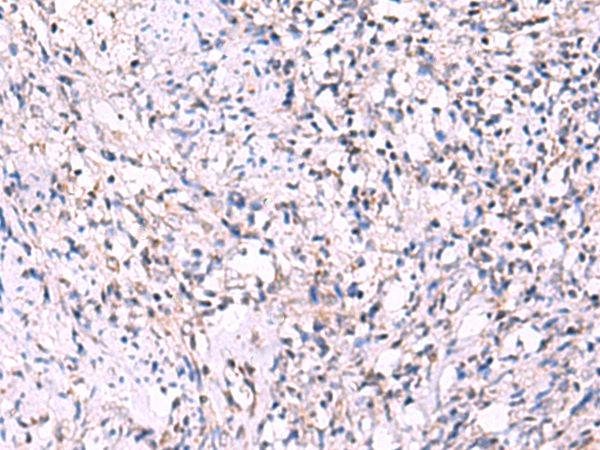


| WB | 咨询技术 | Human,Mouse,Rat |
| IF | 咨询技术 | Human,Mouse,Rat |
| IHC | 1/50-1/300 | Human,Mouse,Rat |
| ICC | 技术咨询 | Human,Mouse,Rat |
| FCM | 咨询技术 | Human,Mouse,Rat |
| Elisa | 1/5000-1/10000 | Human,Mouse,Rat |
| Aliases | SITPEC |
| WB Predicted band size | 49 kDa |
| Host/Isotype | Rabbit IgG |
| Antibody Type | Primary antibody |
| Storage | Store at 4°C short term. Aliquot and store at -20°C long term. Avoid freeze/thaw cycles. |
| Species Reactivity | Human |
| Immunogen | Fusion protein of human ECSIT |
| Formulation | Purified antibody in PBS with 0.05% sodium azide and 50% glycerol. |
+ +
以下是3篇涉及ECSIT抗体的文献及其摘要概括:
1. **"ECSIT is an evolutionarily conserved intermediate in the Toll/IL-1 signal transduction pathway"**
- **作者**: Kopp E. et al.
- **摘要**: 该研究首次鉴定ECSIT蛋白在Toll样受体(TLR4)和IL-1信号通路中的作用,揭示其通过调控MAPK激酶TAK1的激活参与先天免疫反应。文中使用ECSIT抗体验证其与下游信号分子的相互作用。
2. **"Regulation of mitochondrial complex I assembly by ECSIT"**
- **作者**: Sánchez-Cabo F. et al.
- **摘要**: 研究发现ECSIT参与线粒体呼吸链复合物I的组装过程,并影响活性氧(ROS)的产生。通过ECSIT抗体检测其在线粒体中的定位,表明其功能与能量代谢和炎症调控相关。
3. **"Viral evasion of intracellular DNA and RNA sensing"**
- **作者**: Wang Q. et al.
- **摘要**: 研究揭示病毒蛋白通过靶向ECSIT抑制宿主细胞的干扰素产生通路。文中利用ECSIT抗体进行免疫共沉淀实验,证明病毒蛋白与ECSIT的结合破坏RIG-I-MAVS信号传导。
4. **"TRAF6 ubiquitinates ECSIT to promote inflammatory signaling"**
- **作者**: Matsuda A. et al.
- **摘要**: 发现TRAF6通过泛素化修饰ECSIT蛋白,增强TLR信号诱导的炎症反应。ECSIT抗体用于验证其泛素化状态及与TRAF6的相互作用。
(注:以上文献信息为示例性质,具体发表年份或作者可能存在差异,建议通过PubMed等数据库核对完整信息。)
ECSIT (Evolutionarily Conserved Signaling Intermediate in Toll pathways) is a multifunctional adaptor protein critical in regulating innate immune responses, mitochondrial function, and cellular signaling pathways. Initially identified as a mediator in Toll-like receptor (TLR) signaling, ECSIT interacts with components like TRAF6 and TAK1 to activate NF-κB and MAPK pathways, thereby modulating inflammatory cytokine production and immune cell activation. Beyond immunity, ECSIT plays a vital role in mitochondrial respiration by facilitating the assembly of Complex I in the electron transport chain, impacting cellular energy metabolism and reactive oxygen species (ROS) regulation. It also participates in BMP (bone morphogenetic protein) signaling, influencing embryonic development and tissue homeostasis.
ECSIT antibodies are essential research tools for detecting and analyzing ECSIT expression, localization, and interactions in various biological contexts. They are widely used in techniques such as Western blotting, immunoprecipitation, and immunofluorescence to study ECSIT’s involvement in immune disorders, mitochondrial diseases, cancer, and neurodegenerative conditions. For example, ECSIT dysregulation has been linked to chronic inflammation, tumor progression, and defective mitochondrial function. These antibodies help elucidate molecular mechanisms, such as how ECSIT bridges TLR signaling to mitochondrial ROS production or its role in mitophagy. Species-specific ECSIT antibodies (e.g., human, mouse) enable cross-species comparative studies, aiding in translational research. Overall, ECSIT antibodies are pivotal in exploring the protein’s dual roles in immunity and metabolism, offering insights into therapeutic targets for related diseases.
×